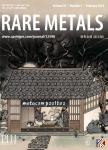Macro-micron-nano-featured surface topography of Ti-6Al-4V alloy for biomedical applications
Macro-micron-nano-featured surface topography of Ti-6Al-4V alloy for biomedical applications作者机构:College of Biology Hunan University Shenzhen Key Laboratory for Additive Manufacturing of High-Performance Materials Department of Materials Science and Engineering Southern University of Science and Technology
出 版 物:《Rare Metals》 (稀有金属(英文版))
年 卷 期:2018年第37卷第12期
页 面:1055-1063页
核心收录:
学科分类:0806[工学-冶金工程] 08[工学] 080501[工学-材料物理与化学] 0805[工学-材料科学与工程(可授工学、理学学位)] 080502[工学-材料学] 0703[理学-化学] 0702[理学-物理学]
基 金:financially supported by the National Natural Science Foundation of China (No. 51604104) Shenzhen Science and Technology Innovation Commission (No. ZDSYS201703031748354) the National Science Foundation of Guangdong Province (No. 2016A030313756)
主 题:Selective laser melting Electrochemical anodization Hierarchical surface Cell adhesion Cell proliferation
摘 要:One of the critical issues in the development of novel metallic biomaterials is the design and fabrication of metallic scaffolds and implants with hierarchical structures mimicking human bones. In this work, selective laser melting(SLM) and electrochemical anodization were applied to fabricate dense Ti-6 A1-4 V components with macro-micron-nanoscale hierarchical surfaces. Scanning electron microscopy(SEM), 3 D laser scanning microscopy(3 D LSM), contact angle video system, fluorescence microscopy and spectrophotometer were used to investigate the properties of the samples. The results reveal that the SLMed post-anodization(SLM-TNT) exhibits enhanced or at least comparable wettability, protein adsorption and biological response of mesenchymal stem cells(MSCs) in comparison with the three reference configurations, i.e., the polished Ti-6 Al-4 V(PO-Ti64), the SLMed Ti-6 A1-4 V(SLM-Ti64) and the polished Ti-6 A1-4 V post-anodization(PO-TNT). The improved cytocompatibility of the samples after SLM and anodization should be mainly attributed to the nanoscale tubular features,while the macro-micron-scale structures only lead to slight preference for cell attachment.



